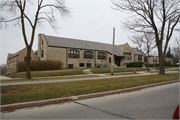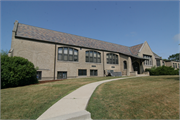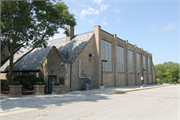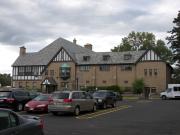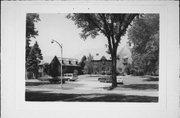Property Record
6401 N SANTA MONICA BLVD
Architecture and History Inventory
| Historic Name: | Milwaukee Country Day Senior School |
|---|---|
| Other Name: | Milwaukee Jewish Federation |
| Contributing: | Yes |
| Reference Number: | 9322 |
| Location (Address): | 6401 N SANTA MONICA BLVD |
|---|---|
| County: | Milwaukee |
| City: | Whitefish Bay |
| Township/Village: | |
| Unincorporated Community: | |
| Town: | |
| Range: | |
| Direction: | |
| Section: | |
| Quarter Section: | |
| Quarter/Quarter Section: |
| Year Built: | |
|---|---|
| Additions: | |
| Survey Date: | 201120121980 |
| Historic Use: | school – elem/middle/jr high/high |
| Architectural Style: | English Revival Styles |
| Structural System: | |
| Wall Material: | Brick |
| Architect: | |
| Other Buildings On Site: | |
| Demolished?: | No |
| Demolished Date: |
| National/State Register Listing Name: | Not listed |
|---|---|
| National Register Listing Date: | |
| State Register Listing Date: |
| Additional Information: | The Milwaukee Country Day School, a private school for boys, was an outgrowth of earlier schools in Milwaukee. In 1911, several fathers persuaded A. Gledden Santer to found a day school in Milwaukee. Located at Farwell and Ogden Avenues and named St. Bernard’s, it housed high school grades. Soon thereafter, an elementary school began on Brady Street, and in 1919, moved to the old Lakeside Hospital located on Prospect Avenue at Woodstock Place. In 1916, 24 acres of land were purchased for expansion in Whitefish Bay to follow the country day school model popular at that time. The purpose of which was to provide boys with the school life of a boarding school without separating them from the influences of home life, made possible by locating the school in the country on the outskirts of a city. Only the kindergarten at the Milwaukee Country Day School was co-ed, and each class was limited to less than 25 students. The Senior School, housing grades eight through twelve, opened in Whitefish Bay for fall of 1917. It was constructed of brick in the Tudor Revival style at 6401 N. Santa Monica Boulevard. A gymnasium addition was constructed on the west side of the Senior School in 1919 for $50,000. $120,000 was spent on remodeling in 1935. Demand for accommodation of out-of-town students was finally met in 1926, when the school began renting a house on the 6-acre George P. Dravo estate at the northeast corner of Santa Monica Boulevard and School Road in adjacent Fox Point. The property was later purchased. The two-story house on was remodeled into a dormitory to house fifteen students. Plans were made to construct a row of master’s houses on the site as well. A home on Santa Monica Boulevard was purchased for the headmaster around 1943. However, the school’s boarding program ended just before World War II when a student sleepwalked onto a terrace and plunged to his death. Not long after, the school sold the dormitory. The Junior School, housing the kindergarten through grade seven, continued to be taught on Prospect Avenue until a new building was constructed on the Whitefish Bay campus in 1931 at 6255 N. Santa Monica Boulevard. It was constructed for $180,000 with major donations from Irving Seaman, Charles Wright, George P. Miller, and L. R. Smith. The Junior School’s brick and stone building was designed in the Tudor Revival style by architect Fitzhugh Scott; it was U-shaped, with a two-story center and one-story wings. Cloistered arches lined the inner courtyard through which the classrooms were individually accessed. Each classroom of the Junior School was uniquely finished with different species of wood, unique light fixtures, and individually designed fireplaces. In addition to classrooms, the Junior School also housed a library, auditorium, and dining hall. In 1933, funded by the sale of the Prospect Avenue Lakeside Hospital property, a $125,000 addition, also designed by Fitzhugh Scott, added 15 classrooms, a swimming pool, and a new library. The Milwaukee Country Day School’s spacious grounds offered space for baseball and football fields, three tennis courts, and two hockey rinks. Originally, a small orchard was located north of the Junior School. During the summer of 1935, a wading pool, fireplace, and fountain were installed as a memorial on the grounds, donated by the parents of a former student. As most of the school’s students and faculty lived in the City of Milwaukee’s Lower East Side, the school relied heavily on the Lake Drive trolley line ending at School Road, which was nicknamed the “Yellow Streak.” During the Great Depression, the opening up of enrollment to girls was considered but never implemented; negotiations had even begun for merger with the Lake School for Girls. A brief discussion of merger with the Downer Seminary occurred in1940, but was soon dropped. However, the Milwaukee Country Day School merged with the Milwaukee Downer Seminary and Milwaukee University School in 1964. The new school’s female campus was located at the Milwaukee University School’s facilities at 2100 W. Fairy Chasm Road in Fox Point. Country Day’s remodeled campus went on to serve as the new University Day School’s male campus. In 1970, the former University Day Senior School building was renamed and reorganized as the University School of Milwaukee’s co-ed high school campus. Co-ed elementary and middle school grades were taught in Fox Point until all of the University Day School’s campuses were consolidated to Fox Point in 1985. Later that year, the University Day School properties on Santa Monica Boulevard were sold to the Milwaukee Jewish Federation for $2.7 million to become their Max and Anita Karl Community Campus. The Milwaukee Jewish Day School was founded in 1981. It serves kindergarten through the eighth grade. In 1987, the school relocated from 2419 E. Kenwood Boulevard in Milwaukee to the Karl Community Campus of the Milwaukee Jewish Federation, on the site of the former Milwaukee Country Day School on Santa Monica Boulevard in Whitefish Bay. At this time, the school was located in what had been renamed the Soref Building at 6255 N. Santa Monica Boulevard. After eighteen months, the school moved to its current building at 6401 N. Santa Monica Boulevard, renamed after Max and Mary Kohl who donated $1 million for the building’s renovation. Also presently located in the Kohl Education Building are the Milwaukee Association for Jewish Education and the Hillel Academy, another private elementary school. Following Milwaukee’s Jewish community’s general shift to its suburbs, the Harry & Rose Samson Family Jewish Community Center purchased the 28-acre University Day School Campus at 6255 and 6401 N. Santa Monica Boulevard in 1987. The Jewish Communtiy Center’s (JCC) forerunner began in 1894 as the Jewish Mission and was originally located at the Temple Emanu-El B’ne Jeshurun at 10th and Cedar Streets in Milwaukee. By 1900, the Mission coalesced with the Jewish Women and the Sisterhood of Personal Service under the new name Milwaukee Jewish Settlement and rented several other locations in Milwaukee’s inner city. In 1911, the Settlement purchased the Abraham Lincoln House on 9th and Vine Streets in Milwaukee, where the group met until its move to the University High School on Milwaukee Street. In 1946, the group officially changed its name to the Jewish Community Center. 1955 marked the first move for the JCC away from Milwaukee’s inner city towards suburbs of Milwaukee with its purchase of a site on Lake Michigan at 1400 N. Prospect Avenue, where it was located until its move to Whitefish Bay in 1987. Since its earliest years the JCC has sought to provide social, educational, recreational, and cultural programs and activities including: sewing, cooking, English classes, music, and multiple social clubs. In 1998, an additional 73 acre site was purchased in Mequon for future expansion which resulted in the 2007 Hy & Richard Smith JCC Family Park. To this day, the facilities on Santa Monica Boulevard are still in active use, as multiple additions and renovations have enlarge what is now referred to as the JCC’s Karl Campus. 2012 - Appearance unchanged. U-shape plan with cross gables and hipped dormers. The building is clad entirely in brick apart from the gables, which are each adorned with decorative half-timbering. Other identifying features of the Tudor Revival style exhibited by this building include Tudor arch doorways, oriel windows, brick buttresses, and stacked chimneys. |
|---|---|
| Bibliographic References: | Building permit records on file at Whitefish Bay Village Hall. Harry & Rose Samson Family Jewish Community Center website. <http://www.jccmilwaukee.org> Whitefish Bay Historical Research Project. Volume 9. Mimi Bird Collection, Whitefish Bay: Whitefish Bay Public Library “Architecture and History Survey: I-43” WHS project number 12-0649/MI/OZ. 2012. Prepared by Mead & Hunt Inc. |
| Wisconsin Architecture and History Inventory, State Historic Preservation Office, Wisconsin Historical Society, Madison, Wisconsin |

